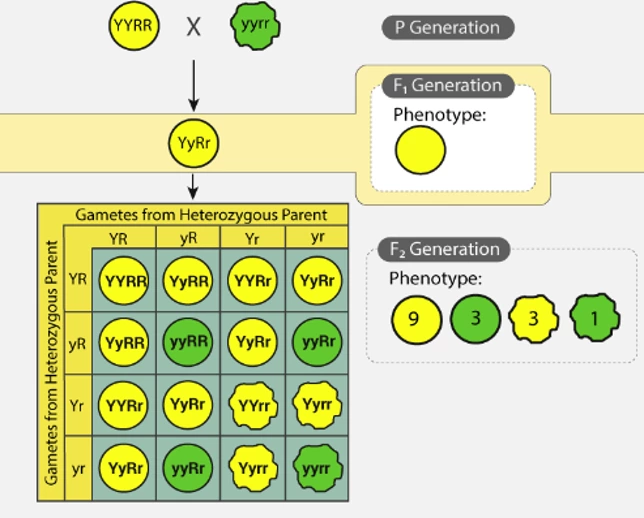Which Mendel's law of inheritance is universally acceptable and without any exception? State the law
Mendel's Law of Inheritance
The law of segregation: the factors or alleles present in pairs segregate during gamete formation
In the year between 1856-1863, Mendel led the hybridization experiments on the garden peas. During that period, he picked some unmistakable qualities of the peas and led a few cross-fertilization/counterfeit fertilization on the peas lines that indicated stable attribute legacy and experienced consistent self-fertilization. Such pea lines are called genuine reproducing pea lines.
For what reason was Pea Plant Selected for Mendel's Experiments?
He chose a pea plant for his trials:
- The pea plant can be effectively developed and kept up.
- There are normally self-pollinating yet can likewise be cross-pollinated.
- It is a yearly plant, in this way, numerous ages can be contemplated inside a brief timeframe.
- It has a few differentiating characters.
Mendel led 2 principle examinations to decide the laws of legacy. These tests were:
- Monohybrid Cross Experiment
- Dihybrid Cross Experiment
While testing, Mendel found that specific components were continually being moved down to the off springs in a steady manner. Those components are presently called qualities for example qualities can be called as the units of legacy.
Mendel's Experiments
Mendel investigated a pea plant and considered 7 principle differentiating qualities in the plants. At that point, he directed both the examinations to decide the previously mentioned legacy laws. A concise clarification of the two analyses is given underneath.
Monohybrid Cross
In this investigation, Mendel took two pea plants of inverse attributes (one short and one tall) and crossed them. He found the original off springs were tall and called it F1 descendants. At that point he crossed F1 descendants and acquired both tall and short plants in the proportion 3:1. To find out about this test, visit Monohybrid Cross – Inheritance of One Gene.
Mendel even led this investigation with other differentiating qualities like green peas versus yellow peas, round versus wrinkled, and so forth. In every one of the cases, he found that outcomes were comparative. From this, he detailed the laws of Segregation and Dominance.
Dihybrid Cross
In a dihybrid cross analysis, Mendel thought about two qualities, each having two alleles. He crossed wrinkled-green seed and adjust yellow seeds and saw that all the original descendants (F1 offspring) were round-yellow. This implied predominant characteristic were the round shape and yellow shading.
He then self-pollinated the F1 descendants and acquired 4 unique characteristics wrinkled-yellow, round-yellow, wrinkled-green seeds and round-green in the proportion 9:3:3:1.

In the wake of directing for different attributes, the outcomes were seen as comparative. From this trial, Mendel figured his second law of legacy i.e law of Independent Assortment.
Conclusions from Mendel's Experiments
- The hereditary cosmetics of the plant is known as the genotype. Despite what might be expected, the physical appearance of the plant is known as phenotype though
- The qualities are moved from guardians to the off springs two by two known as allele.
- During game to beginning when the chromosomes are split, there is a half possibility of one of the two alleles to combine with the other parent.
- When the alleles are same they are known as homozygous alleles when the alleles are distinctive they are known as heterozygous alleles.
Laws of Inheritance
The two examinations lead to the definition of Mendel's laws known as laws of legacy which may be:
1. Law of Dominance
2. Law of Segregation
3. Law of Independent Assortment
Law of Dominance
This is likewise called as Mendel's first law of legacy. As indicated by the law of strength, half breed off springs will just acquire the prevailing quality in the phenotype. The alleles that are stifled are called as the latent qualities while the alleles that decide the attribute are known as the lethargic characteristics.
Law of Segregation
The law of isolation expresses that during the creation of gametes, two duplicates of each innate factor isolate with the goal that posterity get one factor from each parent. At the end of the day, allele (elective type of the quality) sets isolate during the development of gamete and re-join haphazardly during preparation. This is otherwise called Mendel's third law of legacy.
Law of Independent Assortment
Otherwise called Mendel's second law of legacy, the law of free arrangement expresses that a couple of characteristic isolates autonomously from another pair during gamete development. As the individual heredity factors arrange freely, various attributes get equivalent chance to happen together.

Topper's Solved these Questions
- GENETICS AND EVOLUTION BOOK - TRUEMAN BIOLOGYCHAPTER - GENETICS AND EVOLUTION EXERCISE - SECTION-D
25 Videos
- GeneticsBOOK - TRUEMAN BIOLOGYCHAPTER - GeneticsEXERCISE - ASSERTION AND REASON
123 Videos
- HUMAN HEALTH AND DISEASEBOOK - TRUEMAN BIOLOGYCHAPTER - HUMAN HEALTH AND DISEASEEXERCISE - MULTIPLE CHOICE QUESTIONS
213 Videos
Similar Questions
Knowledge Check
Mendel's last law is
AsegregationBdominanceCindependent assortmentDpolygenic inheritanceMendel's law of segregation is applicable to
ADihybrid cross onlyBBoth dihybrid and monohybrid crossesCMonohybrid cross onlyDDihybrid but not monohybrid crossMendel's law of segregation is also known as
ALaw of seperationBLaw of dominanceCLaw of purity of gametesDLaw of independent assotment
